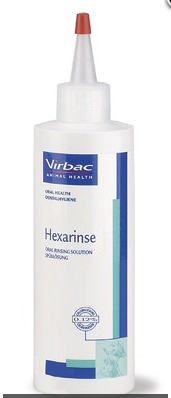Virbac Hexarinse oral health Dentalhygiene 237ml
Indications
Hexarinse is an aid in the prevention of tartar, plaque and periodontal disease in dogs, cats and horses. Hexarinse can be used to reduce gingivitis and resolve oral inflammation. It may also be used to prevent secondary bacterial infections following oral surgery. After dental scaling, Hexarinse should be used to rinse the mouth and irrigate periodontal pockets to kill residual bacteria and promote the resolution of inflammation.
Directions For Use
Shake well before use.
Dogs and Cats
In clinic: Before, during and after de-scaling. At Home: Rinse daily following each meal or as directed
by your veterinarian.
Hold the bottle in the upright position and below your pet’s field of vision. Gently pull the upper lip back to expose the teeth and gingiva. Point the nozzle and squeeze the bottle to apply a gentle stream of Hexarinse.The foaming formulation of Hexarinse will allow a quick dispersion and complete coverage of the oral cavity, even in those areas that are difficult to reach.
Mode Of Action
At physiological pH, bacteria have a negatively charged surface and chlorhexidine binds to this. Depending on the concentration, chlorhexidine will then have a bacteriostatic or bactericidal effect. Chlorhexidine disrupts the osmotic regulation
and enzyme co-ordination of the bacteria causing immediate membrane permeability and release of cell constituents.
Chlorhexidine’s mode of action is non-specific, making it virtually impossible for resistant strains of micro-organisms to develop. Initially, the chlorhexidine electroscopically binds at multiple sites on the microbe’s surface, causing disruption to the cell membrane transport system.The resulting osmotic imbalance increases membrane permeability, allowing chlorhexidine to enter the cell, where it precipitates the cell’s contents, causing cell death.
Chlorhexidine binds to the dental pellicle and reduces binding of plaque components. It inhibits bacteria within existing plaque, preventing development of a sticky matrix on the tooth which contributes to further plaque development.
Chlorhexidine causes some breakdown of existing plaque (although manual removal and dental surgery is recommended to remove macroscopic masses). It renders existing plaque non-pathogenic by killing bacteria and preventing production of the metabolic products which cause gingivitis and progressive periodontal disease.
Chlorhexidine has a strong affinity for mucosae and the surface of teeth with which it links giving great retention. After one application, sufficient concentration remains to be effective for up
to 12 hours. Most other antiseptics have poor substantivity and are quickly washed away by saliva.
Zinc has been shown to enhance the anti-plaque activity of chlorhexidine and to help reduce the accumulation of plaque and calculus. Zinc inhibits plaque maturation, allowing chlorhexidine to penetrate in to the deeper layers and helps to reduce halitosis by inhibiting the production and release of volatile sulphur compounds (the primary component of oral malodor). In addition, it aids in preventing and reversing some of the toxic effects of bacteria. Zinc has been used in human oral hygiene for decades and has no known adverse side effects when used at the levels recommended.
Horses
In clinic: Before, during and after dental procedures including flushing of periodontal pockets. A gentle stream of Hexarinse is applied to the periodontal pocket to flush the pocket and remove debris and food material.
At Home: Rinse daily. After selecting the appropriate volume as directed by your veterinarian, the product is administered orally either directly via a syringe or with the aid of a pressurized dispenser with tubing and catheter.The foaming formulation of Hexarinse will allow a quick dispersion, even in those areas that are difficult to reach.


